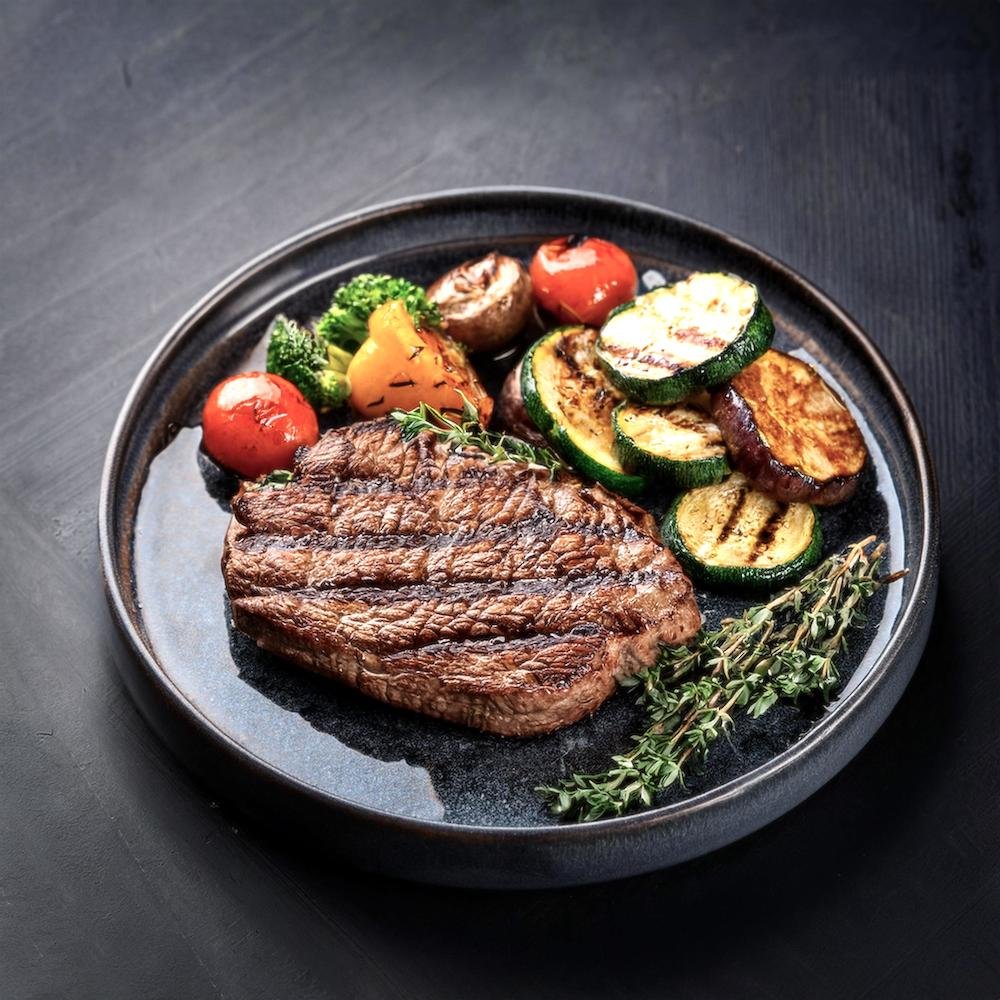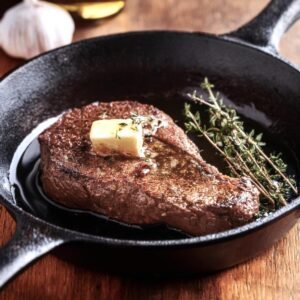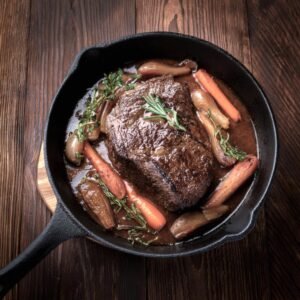What’s the best way to cook chuck eye? Often called the “poor man’s ribeye,” chuck eye steak is a versatile and flavorful cut of beef that delivers exceptional taste when cooked correctly. Its rich marbling provides a beefy flavor reminiscent of ribeye, but it benefits from thoughtful preparation to bring out its best qualities.
Whether you’re grilling for a steakhouse experience, pan-searing for a quick dinner, or braising for melt-in-your-mouth tenderness, understanding what’s the best way to cook chuck eye ensures you maximize its potential. This guide will cover everything from preparation to cooking tips, helping you achieve a tender, delicious steak every time.
What Makes Chuck Eye Steak Unique?
Chuck eye steak is cut from the shoulder (or chuck) primal, specifically near the 5th rib. Its proximity to the ribeye section gives it a similar flavor profile, though it is slightly less tender due to the presence of connective tissue.
Characteristics of Chuck Eye Steak
- Flavor Profile:
- Chuck eye steak is known for its robust, beefy flavor.
- Its marbling enhances its juiciness and creates a steakhouse-quality taste.
- Texture:
- Slightly firmer than ribeye, but proper cooking techniques like marinating or slow cooking can make it tender and succulent.
- Affordability:
- Chuck eye steak is a budget-friendly option, making it a great alternative to more expensive cuts like ribeye.
Pro Tip: Look for chuck eye steaks with visible marbling for better flavor and tenderness.
Best Cooking Methods for Chuck Eye Steak
Chuck eye steak is versatile and adapts well to different cooking methods. The key is to match the cooking technique to the steak’s characteristics for the best flavor and tenderness.
1. Grilling for a Steakhouse Feel
- Why It Works:
- Grilling uses high heat to caramelize the marbling, creating a flavorful crust while keeping the inside juicy.
- How to Grill Chuck Eye Steak:
- Preheat the grill to high heat (450°F–500°F).
- Season the steak generously with salt, pepper, and garlic powder.
- Grill for 4–5 minutes per side for medium-rare (135°F), or adjust based on your preferred doneness.
- Rest for 5–10 minutes before slicing.
Pro Tip: Brush the steak with melted herb butter during the last minute of grilling for an extra burst of flavor.
2. Pan-Searing for Quick Meals
- Why It Works:
- Pan-searing delivers a golden crust and locks in the steak’s natural juices, making it ideal for weeknight dinners.
- How to Pan-Sear Chuck Eye Steak:
- Heat a cast-iron skillet over medium-high heat. Add a tablespoon of high-smoke-point oil, such as avocado or vegetable oil.
- Sear the steak for 3–4 minutes per side. For thicker cuts, finish cooking in a preheated 375°F oven for 5–7 minutes.
- Baste the steak with melted butter, garlic, and fresh thyme during the last minute of cooking.
Pro Tip: Use a meat thermometer to ensure the steak reaches the desired internal temperature (135°F for medium-rare).
3. Braising for Tenderness
- Why It Works:
- Braising uses low, moist heat to break down connective tissue, making the steak fork-tender and flavorful.
- How to Braise Chuck Eye Steak:
- Sear the steak in a hot skillet until browned on both sides, then set it aside.
- Sauté onions, garlic, and carrots in the same skillet, and deglaze with beef broth, wine, or tomato sauce.
- Return the steak to the skillet, cover, and simmer on low heat for 2–3 hours, or bake in a 300°F oven.
Pro Tip: Add fresh herbs like thyme or rosemary to the braising liquid for enhanced flavor.
4. Slow Cooking for Set-It-and-Forget-It Meals
- Why It Works:
- The slow cooker tenderizes the meat over several hours, resulting in a melt-in-your-mouth texture.
- How to Slow Cook Chuck Eye Steak:
- Layer the steak in a slow cooker with onions, garlic, and vegetables.
- Pour in beef broth, barbecue sauce, or a marinade to cover the steak halfway.
- Cook on low for 6–8 hours or high for 4–5 hours.
Pro Tip: Shred the slow-cooked steak and use it for tacos, sliders, or sandwiches.
5. Broiling for a Quick, High-Heat Option
- Why It Works:
- Broiling uses direct heat to cook the steak quickly while developing a charred crust.
- How to Broil Chuck Eye Steak:
- Preheat the broiler and position the oven rack 4–6 inches from the heat source.
- Season the steak with olive oil, salt, and pepper, and place it on a broiler-safe pan.
- Broil for 3–4 minutes per side, flipping once, until the steak reaches your desired doneness.
Pro Tip: Keep a close eye on the steak to prevent overcooking under the intense broiler heat.
Step-by-Step Guide to Cooking Chuck Eye Steak
Follow this step-by-step guide to prepare chuck eye steak using the most popular cooking methods.
Preparing Chuck Eye Steak
- Choose the Right Cut:
- Look for chuck eye steak with visible marbling and minimal gristle for the best flavor and texture.
- Tenderize If Needed:
- Use a meat mallet to break down tough fibers if the steak feels firm.
- Marinate for Extra Flavor:
- Combine olive oil, garlic, soy sauce, and fresh herbs in a bowl.
- Place the steak in the marinade and refrigerate for at least 2 hours or overnight.
Pro Tip: Add lemon juice or vinegar to the marinade to help tenderize the meat.
Grilling Chuck Eye Steak
- Preheat the Grill:
- Heat your grill to high (450°F–500°F) and clean the grates to prevent sticking.
- Season the Steak:
- Pat the steak dry and season generously with salt, pepper, and your favorite spices.
- Grill the Steak:
- Place the steak on the grill and sear for 4–5 minutes on each side for medium-rare. Use a meat thermometer to check for an internal temperature of 135°F.
- Rest and Serve:
- Let the steak rest for 5–10 minutes to allow the juices to redistribute. Slice against the grain for maximum tenderness.
Pan-Searing Chuck Eye Steak
- Heat the Skillet:
- Preheat a cast-iron skillet over medium-high heat and add a tablespoon of oil.
- Sear the Steak:
- Place the steak in the hot skillet and sear for 3–4 minutes per side until a crust forms.
- Finish in the Oven:
- For thicker cuts, transfer the skillet to a preheated 375°F oven and cook for 5–7 minutes until the desired doneness is reached.
- Baste and Serve:
- During the last minute of cooking, baste the steak with melted butter, garlic, and thyme for added flavor. Let it rest before serving.
Braising Chuck Eye Steak
- Sear the Steak:
- Heat oil in a large skillet over medium-high heat and sear the steak until browned on both sides.
- Prepare the Braising Liquid:
- In the same skillet, sauté onions, garlic, and carrots. Deglaze with beef broth, red wine, or tomato sauce.
- Simmer or Bake:
- Return the steak to the skillet, cover, and simmer on low heat for 2–3 hours. Alternatively, transfer to a 300°F oven for slow cooking.
- Finish and Serve:
- Garnish with fresh parsley and serve with mashed potatoes or crusty bread.
Slow Cooking Chuck Eye Steak
- Prepare the Ingredients:
- Layer the steak in a slow cooker with chopped onions, garlic, and vegetables.
- Add Liquid:
- Pour in beef broth, barbecue sauce, or a flavorful marinade to cover the steak halfway.
- Set the Cooker:
- Cook on low for 6–8 hours or high for 4–5 hours.
- Shred or Serve Whole:
- Once cooked, shred the steak for tacos or serve whole with the cooking juices as a sauce.
Tips for Perfect cook chuck eye Steak
To elevate your chuck eye steak, follow these expert tips for enhancing flavor, tenderness, and overall quality.
1. Marinate for Tenderness and Flavor
- Why Marinate?
- Marinating helps break down tougher fibers in the steak while infusing it with rich flavors.
- Best Ingredients for Marinades:
- Acidic bases like vinegar or citrus juice for tenderizing.
- Soy sauce, Worcestershire sauce, or balsamic vinegar for depth of flavor.
- Fresh herbs like thyme, rosemary, or parsley for an aromatic boost.
Pro Tip: Let the steak marinate for at least 2 hours or overnight for maximum flavor.
2. Rest the Steak
- Why It’s Important:
- Resting after cooking allows the juices to redistribute throughout the meat, preventing them from running out when sliced.
- How Long to Rest:
- Let the steak rest for 5–10 minutes under loosely tented foil.
Pro Tip: Resting also helps stabilize the steak’s internal temperature, ensuring even slicing.
3. Use a Meat Thermometer
- Why It Matters:
- A meat thermometer ensures precise cooking and prevents overcooking or undercooking.
- Internal Temperature Guide:
- Rare: 125°F
- Medium-Rare: 135°F
- Medium: 145°F
Pro Tip: Insert the thermometer into the thickest part of the steak for the most accurate reading.
4. Slice Against the Grain
- What It Means:
- Slicing against the grain shortens the muscle fibers, making each bite more tender.
- How to Do It:
- Look for the lines of muscle fibers on the steak and cut perpendicular to them.
Pro Tip: Use a sharp knife for clean, even slices.
5. Enhance with Seasoning and Butter
- Season Generously:
- Salt, pepper, and garlic powder are classic options. Add paprika or chili powder for a smoky kick.
- Basting with Butter:
- During the final minute of cooking, baste the steak with melted butter, garlic, and thyme for added richness.
Pro Tip: Compound butter (butter mixed with herbs or spices) can be placed on top of the steak while it rests for extra flavor.
6. Choose the Right Cooking Method
- Quick Cooking for Tender Cuts:
- Grill or pan-sear for thinner or well-marbled chuck eye steaks.
- Slow Cooking for Tougher Cuts:
- Braise or slow cook for thicker, more fibrous cuts to achieve melt-in-your-mouth tenderness.
Pro Tip: Experiment with different methods to find the perfect match for your cut and recipe.
FAQs “cook chuck eye”
What Is Chuck Eye Steak Good For?
Best Uses: Chuck eye steak is ideal for grilling, pan-searing, and slow cooking.
It works well in recipes that emphasize bold flavors, such as steak sandwiches, fajitas, or steak tacos.
Versatility: While slightly less tender than ribeye, chuck eye steak’s rich marbling makes it suitable for both quick-cooking and slow-cooking methods.
Pro Tip: For a steakhouse-style experience, grill chuck eye steak with a simple seasoning of salt, pepper, and garlic.
What Is the Best Way to Cook Eye Fillets?
Pan-Searing and Oven Finishing: Heat a skillet over medium-high heat and sear the eye fillet for 2–3 minutes per side until a crust forms.
Transfer the skillet to a preheated oven at 375°F and cook for an additional 5–7 minutes for medium-rare.
Grilling: Eye fillets can be grilled over high heat for a similar result. Cook for 3–4 minutes per side for medium-rare.
Pro Tip: Rest the fillet for 5–10 minutes before slicing to preserve its juiciness.
What Is the Best Cooking Method for Chuck Meat?
Best Method: Slow cooking or braising is the best method for chuck meat, as it breaks down connective tissue, resulting in tender, flavorful meat.
For quicker meals, pan-searing or grilling can be effective if the meat is tenderized or marinated beforehand.
Slow Cooking: Use a slow cooker or Dutch oven to braise chuck meat with broth, wine, or tomato sauce for 2–3 hours at low heat.
Pro Tip: Add aromatics like garlic, onions, and fresh herbs to the braising liquid for enhanced flavor.
Is Chuck Eye Steak Good for Pan-Frying?
Yes: Chuck eye steak is excellent for pan-frying, especially when cooked in a cast-iron skillet. The high heat develops a flavorful crust while keeping the inside juicy.
How to Pan-Fry: Preheat the skillet over medium-high heat and add a tablespoon of oil.
Sear the steak for 3–4 minutes on each side until golden brown. For thicker cuts, finish cooking in a 375°F oven.
Pro Tip: During the last minute, baste the steak with melted butter, garlic, and thyme for a restaurant-quality finish.
Suggested Internal Links:
- What Does a Crookie Taste Like?
Discover how flavors and cooking techniques from sweet treats like crookies can inspire savory dishes like chuck eye steak. - How Long Do You Cook a Crookie For?
Explore baking and temperature precision tips that can apply to perfecting steak cooking methods. - Is Beef Chorizo Healthy?
Compare the nutritional aspects and cooking techniques of beef chorizo with chuck eye steak. - Garlic Parmesan Chicken Pasta
Pair a pan-seared chuck eye steak with a creamy pasta dish for a hearty meal. - What’s the Best Way to Cook Beef Chorizo?
Discover versatile cooking methods that enhance the flavor and texture of both beef chorizo and chuck eye steak.
Conclusion
What’s the best way to cook chuck eye? This versatile and flavorful cut shines when prepared with care. Whether you’re grilling it for steakhouse-quality results, pan-searing for a quick meal, or slow-cooking for fork-tender perfection, chuck eye steak offers remarkable flavor and value.
Though not as tender as ribeye, chuck eye steak provides similar richness and juiciness at a fraction of the cost. It works beautifully with marinades, spice rubs, and a variety of cooking methods, making it an excellent choice for everyday meals or special occasions.
Mastering techniques like marinating, proper seasoning, and slicing against the grain will elevate this cut to rival more expensive options. The next time you’re considering what’s the best way to cook chuck eye, experiment with different methods to discover what suits your taste. It’s a steak that’s sure to impress both your taste buds and your budget!
Discover more mouthwatering recipes on our Web Site ! Stay connected and get inspired by following us on Facebook, Instagram, Pinterest, and Twitter for the latest updates!




